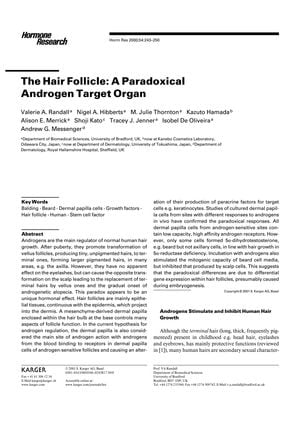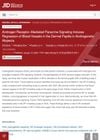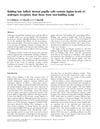The Hair Follicle: A Paradoxical Androgen Target Organ
January 2000
in “Hormone Research in Paediatrics”

TLDR Androgens can both promote and prevent hair growth due to differences in gene expression in hair follicles.
The document from January 1, 2000, examines the contradictory effects of androgens on hair growth, noting that androgens can both stimulate hair growth in certain body areas and cause hair loss on the scalp, a condition known as androgenetic alopecia. It identifies the dermal papilla as the key site of androgen action, where androgens bind to receptors and influence the production of paracrine factors. Studies showed that dermal papilla cells from androgen-sensitive areas have androgen receptors and vary in their ability to form 5α-dihydrotestosterone (DHT), which correlates with hair growth patterns seen in individuals with 5α-reductase deficiency. The document suggests that the differences in hair follicle responses are due to differential gene expression, likely established during embryogenesis. It also discusses the role of paracrine factors and the SCF/KIT pathway in hair follicle behavior, and how these findings could inform treatments for hair disorders related to androgen levels.
View this study on karger.com →
Cited in this study
research Androgen-Dependent Beard Dermal Papilla Cells Secrete Autocrine Growth Factor(s) in Response to Testosterone Unlike Scalp Cells
Beard cells, unlike scalp cells, produce growth factors in response to testosterone, which may explain differences in hair growth.
research Androgen Induction of Follicular Epithelial Cell Growth Is Mediated via Insulin-like Growth Factor-I from Dermal Papilla Cells
Male hormones promote hair cell growth by using a growth factor from nearby skin cells.
Related

research Androgen Receptor-Mediated Paracrine Signaling Induces Regression of Blood Vessels in the Dermal Papilla in Androgenetic Alopecia
Male pattern baldness is linked to higher levels of a certain receptor in the scalp, which leads to the shrinking of blood vessels and hair loss. Early treatment targeting this receptor could be more effective.
research Comparative Study of Some Potential Paracrine Factors Produced by Normal and Androgenetic Alopecia Hair Follicles

research Molecular basis of androgenetic alopecia: From androgen to paracrine mediators through dermal papilla
Male pattern baldness involves hormones and cell signals affecting hair growth.
research Molecular Basis of Androgenetic Alopecia

research Molecular mechanisms of androgenetic alopecia
AGA causes hair loss by shrinking hair follicles due to DHT binding, and can be treated with finasteride and minoxidil.

research The Hair Follicle: A Paradoxical Androgen Target Organ
Androgens can both promote and prevent hair growth due to differences in gene expression in hair follicles.

research Balding hair follicle dermal papilla cells contain higher levels of androgen receptors than those from non-balding scalp
Cells from balding scalps have more androgen receptors than cells from non-balding scalps.
research Cultured dermal papilla cells from androgen-dependent human hair follicles (e.g. beard) contain more androgen receptors than those from non-balding areas of scalp
Beard hair follicles have more androgen receptors than non-balding scalp hair follicles.